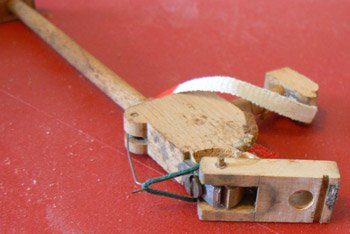|
Split Bridge
I was alerted to look into the bottom of the piano by this sound from
the top bass notes. I am classing this as maintenance because the cost of the full repair (to make and install a new
bass bridge) would be well on the way to a new piano. So, this being a 100-year-old piano, the bridge was glued and
supported by screws to prevent it getting worse. |
|
 |
|
Metal plates (agraffes) were used to support the affected notes, and the strings threaded in the opposite direction to
offset the force from the lower strings. The agraffes are pinned right through the bridge to the soundboard, so they
help to keep the bridge together.
This, as you might expect, is the sound of the repaired notes.
Though certainly not perfect, I charged £100 on top of the tuning fee, and the client has a working piano. |
|
 |
|
|



























